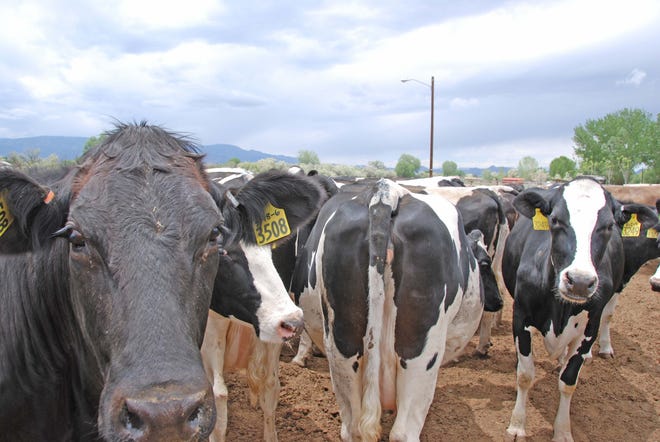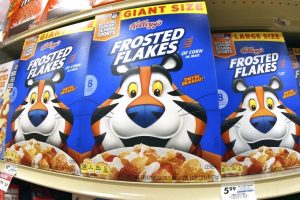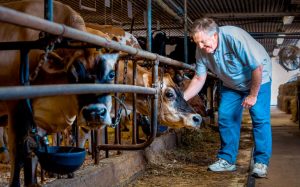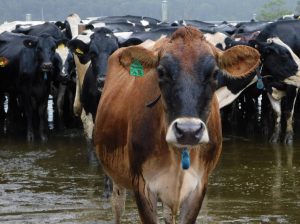A recent webinar, co-hosted by the Dairy MAX regional cooperative and the Colorado Livestock Association, outlined the potential for continued carbon reductions in the dairy industry while also examining the market outlook as the global coronavirus pandemic hammers the world economy.
Presenter Frank Mitloehner, an air quality specialist with the University of California-Davis, reiterated a point that he has made many times: methane emissions from livestock are not the global warming culprit they are often made out to be.
“We have treated methane as a ‘stock’ gas, but it’s not, it’s a flow gas,” he said.
Stock gases build up in the atmosphere and remain there for hundreds or even thousands of years. In contrast, methane breaks down within a decade and is readily taken up by plants through the process of photosynthesis.
“Carbon dioxide and nitrous oxide are long lived. They are the only produced not destroyed,” he explained. “Methane doesn’t just have sources, it also has sinks.”
Regulation and public policy up until now has been based on the idea that methane is roughly equivalent to carbon dioxide, which it is not, he said.
“The methane produced is equal to the amount destroyed over time,” he said. “After 10 years, if the herd size is stable, it will not accumulate in the atmosphere.”
Researchers at Oxford University are working on developing a more accurate carbon dioxide equivalency unit for methane, and groups like the United Nations are starting to see livestock agriculture in a more realistic light, Mitloehner said.
A recent analysis by the World Wildlife Federation acknowledged the positive role large dairies could play in climate change mitigation, noting their potential to reach net-zero emissions within the next five years.
The analysis explored emissions reduction and revenue potential in four primary areas: feed production and efficiency, reducing enteric methane emissions, improving manure management and nutrient recovery, and the generation and sale of renewable energy and byproducts. Mitigation techniques discussed included implementing climate-smart agricultural practices for feed optimization, converting manure into fertilizers and energy, and incentivizing the processing of food waste in biodigesters.
Mitloehner noted that livestock producers have a natural incentive to improve feed efficiency.
When methane is emitted, it represents a loss of energy from the feed the cow has consumed. Normally that level is around 10%, but within the next five years, new feed additives are expected to come on the market capable of reducing methane emissions by an additional 10% to 15%, he said.
Some creameries and food companies have expressed a willingness to pay for these additives to help make their supply chains more sustainable, he said.
Public incentives are also being used to advance methane reduction technologies.
In California, covered lagoons are now being used to trap bio-gas, which is then converted into renewable natural gas, he said.
“Enormous credits are being paid,” Mitloehner said. “It is so significant that we have 150 dairies that have adopted this in the last few years, and we expect an equal number to do so in the next few years. In ten years most of the dairies will have covered lagoons.”
All told, the impact of these changes could reduce methane emissions by 25%, enough to induce a cooling effect, he said.
“Our dairies are on a path to be climate neutrality, and I’m really excited about that,” he said.
Dairy inventories rise, prices fall
Being able to capture credit for carbon reductions could be critical to dairy profitability in the future, along with price risk management and ongoing federal programs such as Dairy Revenue Protection and Dairy Margin Coverage, according to Mark Stephenson, director of dairy policy analysis at the University of Wisconsin.
He talked about long-term consumer trends, the role of exports and the market disruption caused by the viral pandemic.
Both production and consumption plunged in the early months of the pandemic, although production of milk and cheese has since rebounded, he said.
But with restaurants slow to reopen and the vaccine rollout off to a rocky start, domestic consumption has remained uncertain and made export demand even more pivotal, he said.
On the domestic front, there has been some good news. Fluid milk — bolstered by consumption of breakfast cereal — saw a resurgence over the past year. In addition, the Farm to Family Food Box program, implemented by USDA, provided what Stephenson described as “a new and unexpected” source of demand. The popular program will continue to provide a boost as long as it is reauthorized, he said, since cheese and milk make up about 20% of expenditures.
Apart from the pandemic, domestic consumption has fallen behind production growth in recent years.
“Exports are really important to our dairy industry now. They didn’t used to be so important,” Stephenson said.
Domestic consumption of fluid milk, long on a downward trend, essentially “fell off a cliff” in 2010, he said.
While the number of cows continues to decline, overall production continues to rise at a rate of 1.5% to 2% in annual volume, he said.
“Milk per cow goes up every year, and it jumped again in 2020,” he said. The biggest growth has been in the Central Plains states including Colorado, Kansas, Texas and Nebraska.
“Anything above 2%, we can’t eat our way out of the added production, we have to export it,” he said.
Currently, inventories of dairy products are building.
“Butter is going into storage at a rate that ought to be a concern to us in the industry,” he said. “Cheese stocks are also becoming a concern.
























